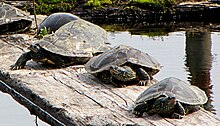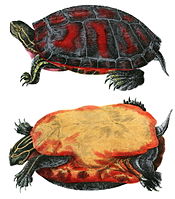| Northern map turtle | |
|---|---|

| |
| Gatineau, Quebec | |
| Conservation status | |
 Least Concern (IUCN 3.1) | |
| Scientific classification | |
| Domain: | Eukaryota |
| Kingdom: | Animalia |
| Phylum: | Chordata |
| Class: | Reptilia |
| Order: | Testudines |
| Suborder: | Cryptodira |
| Superfamily: | Testudinoidea |
| Family: | Emydidae |
| Genus: | Graptemys |
| Species: | G. geographica |
| Binomial name | |
| Graptemys geographica (Lesueur, 1817) | |

| |
| Range map | |
| Synonyms | |
| |
The northern map turtle (Graptemys geographica), also known as the common map turtle, is an aquatic turtle in the family Emydidae. It is endemic to North America.
Description

The northern map turtle gets both its common and scientific names from the markings on its carapace, which resemble contour lines on a map or chart. These lines are usually shades of yellow, tan, or orange, and are surrounded by dark borders, with the rest of the carapace being olive or greyish brown. However, the carapace markings tend to fade as the animal matures, and in older individuals are usually only visible when the shell is wet. The carapace has a hydrodynamic appearance and is broad with a moderately low keel. The rear of the carapace is flared and the rear marginals form serrations. The plastron is yellowish and is marked by a central dark blotch (plastral figure) that follows the sutures of the plastral scutes and fades with age so that many adults lack a pattern all together (i.e., the plastron is immaculate). The head, neck, limbs and tail are dark green with thin yellow stripes, and an oval or triangular spot is located behind each eye. Like other map turtles, this species exhibits extreme sexual size dimorphism; males are 10–16 cm (3.9–6.3 in) in carapace length and weigh between 150–400 g (5.3–14.1 oz), while females are 18–27 cm (7.1–10.6 in) in carapace length and weigh around 0.67–2.5 kg (1.5–5.5 lb). Females have a much wider head than males and this is associated with differences in feeding. Males have a narrower carapace with more distinct keel, narrower head, and a longer, thicker tail. Unlike females, the opening of the cloaca is beyond the rear edge of the carapace. Young map turtles have a pronounced dorsal keel. Hatchlings have a round greyish-brown carapace that is about 2.5 cm (0.98 in) long.

Distribution
Northern map turtles inhabit an area from south Quebec and Ontario to northern Vermont where it lives in the St. Lawrence River drainage basin. Its range extends west through the Great Lakes and into southern Wisconsin and eastern Minnesota, west of the Appalachians, south to Kansas and northwestern Georgia. A population has been found in Northeastern Mississippi. It also occurs in the Susquehanna River system in Pennsylvania and Maryland and the Delaware River. Also, a small European population occurs in the Czech Republic, which was formed from escaped or released turtles and their descendants. In the Czech Republic, this turtle is considered an alien species, but is threatened together with Czech native turtles, other reptiles and amphibians by a large population of another invasive turtle, Trachemys scripta elegans.
Habitat
The northern map turtle inhabits ponds, rivers, and lakes. They prefer large bodies of water and areas with fallen trees and other debris for basking. These turtles are more often found in rivers than in lakes or ponds. They are found in larger rivers and lakes in the northern portion of their range but are more likely to live in smaller rocky rivers and streams in the south and west. Since they are turtles, naturally they need the sun to survive.

Ecology and behaviour
This turtle is dormant November through April, depending on local climatic factors. Northern map turtles spend the winter under water and do not surface to breathe, especially when ice cover makes this impossible. Adults rest on the bottom or wedged underneath rocks or logs and often hibernate communally with other northern map turtles where they may remain somewhat active throughout the entirety of the winter.Hibernacula must be well oxygenated because, unlike some other turtle species such as painted turtles, map turtles need to absorb oxygen from the water to survive the winter. They typically bask in groups and are diurnal, meaning they are active exclusively in daylight hours. Northern map turtles are also quite shy and difficult to approach; they usually slip into the water and hide at the first hint of danger.
Reproduction
Northern map turtles breed in the spring and fall. Most mating takes place in deep waters. The nesting period lasts from May to July. Unshaded sites with sandy soil are highly preferred. The female usually chooses well-drained areas for depositing the eggs. The nest cavity is dug with the hind feet. The size of the clutch is between six and 20. The eggs are oval, about 3.2 cm (1.3 in) long, and have a flexible shell. After the eggs are laid, the cavity is filled. They hatch after 50 to 70 days of incubation, and most hatchlings emerge in August to September. When a nest hatches late, the northern map turtle hatchlings have been known to overwinter in the nest. The female usually lays two or more clutches in one breeding season. The sexes of the young are determined by the temperature. At 25 °C (77 °F), incubation produces a majority of males, whereas 30 to 35 °C (86 to 95 °F) yields more females.
Diet
Map turtles are more carnivorous than most other members of the family Emydidae, and this includes the northern map turtle. Adult females have wide heads, strong jaws and broad alveolar crushing surfaces in their mouths which they use to feed on molluscs, their primary prey, as well as insects and crayfish. Adult males are much smaller and have narrower heads and feed on smaller molluscs and insects. Like most other aquatic turtles, feeding always takes place in the water. In places where invasive molluscs such as zebra mussels and Asian clams (Corbicula fluminea) are abundant, they may become the most important food of female northern map turtles.
Existing protection and conservation status

Map turtles are considered habitat specialists and may be replaced by a more tolerant species when their habitat is altered. The effects of human interference by way boating and recreation on shorelines are likely impeding the map turtle from re-establishing itself in natural areas. Thus, populations of Northern map turtles have probably declined across their entire natural range but they remain widespread and may be abundant in some locations. The species is classified as least concern by the IUCN.
United States
Collecting, keeping, and selling of northern map turtles is prohibited by Animals in Captivity regulations in nine states. It is considered endangered in Kansas, Kentucky, and Maryland.
Canada
Like most jurisdictions of the United States, Canada lists northern map turtles as a species of special concern. This means that they are being threatened by something but are not yet endangered. They are being watched carefully.
References
- ITIS (Integrated Taxonomic Information System). www.itis.gov.
- Fritz, Uwe; Havaš, Peter (2007). "Checklist of Chelonians of the World". Vertebrate Zoology. 57 (2): 149–368. doi:10.3897/vz.57.e30895. S2CID 87809001.
- Stejneger, L., and T. Barbour (1917). A Check List of North American Amphibians and Reptiles. Harvard University Press. Cambridge, Massachusetts. 125 pp. (Graptemys geographica, p. 117.)
- Scientific and Standard English Names of Amphibians and Reptiles of North America, North of Mexico ..., SSARHERPS.org
- : Status Report of the Northern Map Turtle Committee on the Status of Endangered Wildlife in Canada
- ^ Ernst, C.H., and J.E. Lovich. (2009). Turtles of the United States and Canada. 2nd Edition. Washington: Smithsonian Institution Press. (Graptemys geographica, pp. 293–302.)
- Brown, Grover J (31 December 2020). "Discovery of the Northern Map Turtle (Graptemys geographica LeSueur 1817) in Far Northeastern Mississippi". Chelonian Conservation and Biology. 19 (2). doi:10.2744/CCB-1416.1. S2CID 230507114.
- Gordon, D.M. and R.D. MacCulloch (1980). "An investigation of the ecology of the map turtle, Graptemys geographica (Le Sueur) in the northern part of its range". Canadian Journal of Zoology. 58 (12): 2210–2219. doi:10.1139/z80-303.
- Robichaud, Jessica A.; Bulté, Grégory; MacMillan, Heath A.; Cooke, Steven J. (1 March 2023). "Five months under ice: biologging reveals behaviour patterns of overwintering freshwater turtles". Canadian Journal of Zoology. 101 (3): 152–162. doi:10.1139/cjz-2022-0100. ISSN 0008-4301. S2CID 253199672.
- Lindeman, P.V. (2006). Zebra and quagga mussels (Dreissena spp.) and other prey of a Lake Erie population of common map turtles (Emydidae: Graptemys geographica). Copeia 2006(2):268-273.
- Pritchard, P.C.H. 1997. "Conservation strategies - an overview: Implications for management". pp. 467–471 In: Proceedings: Conservation, Restoration, and Management of Tortoises and Turtles - An International Conference. New York Turtle and Tortoise Society.
- St. Lawrence Centre (1996). State of the Environment Report on the St. Lawrence River. Volume 1: The St. Lawrence Ecosystem. Environment Canada - Quebec Region, Environmental Conservation, and Editions MultiMondes, Montreal. "St. Lawrence UPDATE" series.
- Natureserve (1998). Natural Heritage Central Databases. (Data on North American Animals, developed in collaboration with the Association for Biodiversity Information, U.S. and Canadian Natural Heritage Programs and Conservation Data Centres). www.natureserve.org.
- Northern map turtle, Species at Risk Public Registry
Further reading
- Conant, R., and J.T. Collins. (1998). Reptiles and Amphibians of Eastern and Central North America. Third Edition. Expanded. New York: Houghton Mifflin. 640 pp. ISBN 0-395-90452-8 (paperback). (Graptemys geographica, pp. 167–168 + Plates 3, 6.)
- Harding, J. (1997). Amphibians and Reptiles of the Great Lakes Region. Michigan: The University of Michigan Press. 400 pp. ISBN 0-472-06628-5.
- MacCulloch, R.D. (2002). The ROM Field Guide to Amphibians and Reptiles of Ontario. ROM/McClelland & Stewart. 168 pp. A ROM Science Publication.
- Le Sueur, C.A. (1817). An Account of an American species of Tortoise, not noticed in the systems. Journ. Acad. Nat. Sci. Philadelphia 1(1):86-88 + Plate V. (Testudo geographica)
- Smith, H.M., and E.D. Brodie Jr. (1982). Reptiles of North America: A Guide to Field Identification. Golden Press. New York. 240 pp. ISBN 0-307-13666-3 (paperback). (Graptemys geographica, pp. 50–51.)
External links
- Northern Map Turtle, Illinois Natural History Survey
- Common Map Turtle, Reptiles and Amphibians of Iowa
- Common Map Turtle, Savannah River Ecological Laboratory
| Emydidae family | ||||
|---|---|---|---|---|
| ||||
| Genera |
|  | ||
| Chrysemys | ||||
| Clemmys | ||||
| Deirochelys | ||||
| Actinemys | ||||
| Emys | ||||
| Emydoidea | ||||
| Glyptemys | ||||
| Graptemys | ||||
| Malaclemys | ||||
| Pseudemys | ||||
| Terrapene | ||||
| Trachemys | ||||
| †Wilburemys | ||||
| Phylogenetic arrangement of turtles based on turtles of the world 2017 update: Annotated checklist and atlas of taxonomy, synonymy, distribution, and conservation status. Key: †=extinct. | ||||
| Taxon identifiers | |
|---|---|
| Graptemys geographica |
|